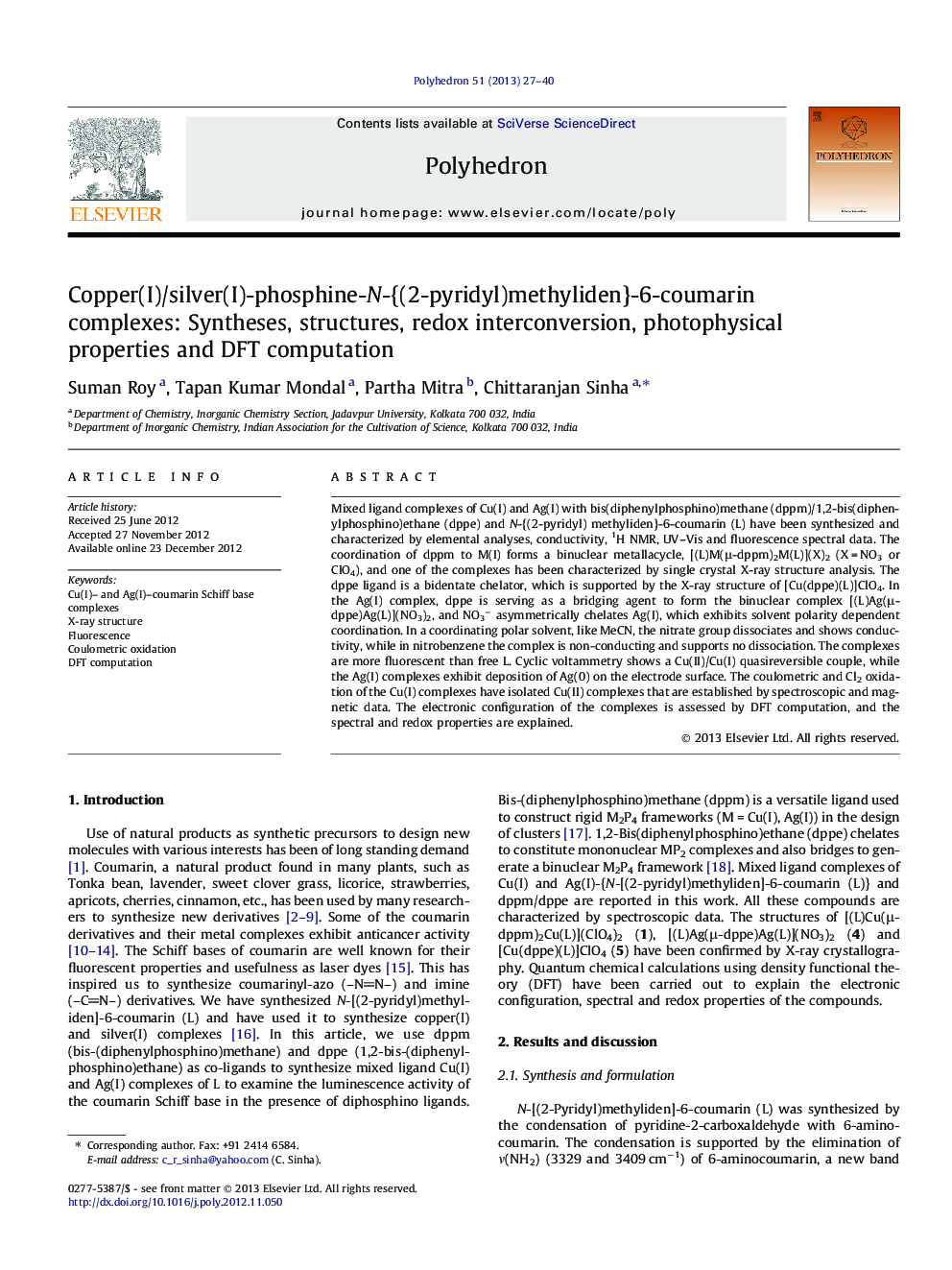| کد مقاله | کد نشریه | سال انتشار | مقاله انگلیسی | نسخه تمام متن |
|---|---|---|---|---|
| 1337144 | 1500288 | 2013 | 14 صفحه PDF | دانلود رایگان |

Mixed ligand complexes of Cu(I) and Ag(I) with bis(diphenylphosphino)methane (dppm)/1,2-bis(diphenylphosphino)ethane (dppe) and N-{(2-pyridyl) methyliden}-6-coumarin (L) have been synthesized and characterized by elemental analyses, conductivity, 1H NMR, UV–Vis and fluorescence spectral data. The coordination of dppm to M(I) forms a binuclear metallacycle, [(L)M(μ-dppm)2M(L)](X)2 (X = NO3 or ClO4), and one of the complexes has been characterized by single crystal X-ray structure analysis. The dppe ligand is a bidentate chelator, which is supported by the X-ray structure of [Cu(dppe)(L)]ClO4. In the Ag(I) complex, dppe is serving as a bridging agent to form the binuclear complex [(L)Ag(μ-dppe)Ag(L)](NO3)2, and NO3− asymmetrically chelates Ag(I), which exhibits solvent polarity dependent coordination. In a coordinating polar solvent, like MeCN, the nitrate group dissociates and shows conductivity, while in nitrobenzene the complex is non-conducting and supports no dissociation. The complexes are more fluorescent than free L. Cyclic voltammetry shows a Cu(II)/Cu(I) quasireversible couple, while the Ag(I) complexes exhibit deposition of Ag(0) on the electrode surface. The coulometric and Cl2 oxidation of the Cu(I) complexes have isolated Cu(II) complexes that are established by spectroscopic and magnetic data. The electronic configuration of the complexes is assessed by DFT computation, and the spectral and redox properties are explained.
N-[(2-Pyridyl)methyliden]-6-coumarin complexes of Cu(I) and Ag(I) in the presence of diphosphines (dppm, dppe) as auxiliary ligands are described. The structures are supported by an X-ray crystallographic study. The complexes are emissive. Electrochemistry shows a Cu(II)/Cu(I) redox couple along with ligand reduction, while Ag(0) deposition is observed for the Ag(I) complexes. Coulometric oxidation of the Cu(I) complexes has separated the Cu(II) complexes and has been supported by EPR spectra. DFT and TD-DFT calculations are used to interpret the spectra and redox properties.Figure optionsDownload as PowerPoint slideHighlights
► N-[(2-Pyridyl)methyliden]-6-coumarin (L) belongs to diimine series of ligand.
► The complexes of copper(I) and silver(I) of L and diphosphines are characterized.
► Copper(I) complexes are more emissive than L.
► Cu(II)/Cu(I) redox response is observed for copper(I) complexes.
► DFT computation supports the electronic structure, spectra and redox properties.
Journal: Polyhedron - Volume 51, 4 March 2013, Pages 27–40